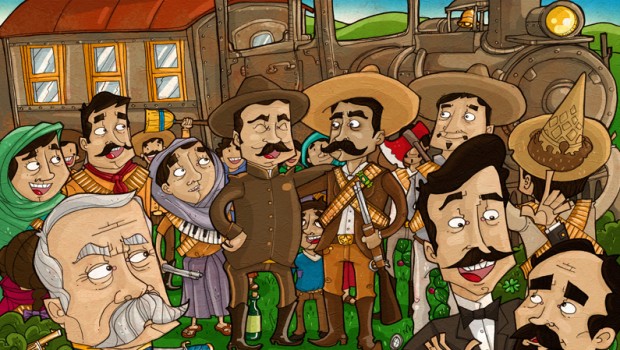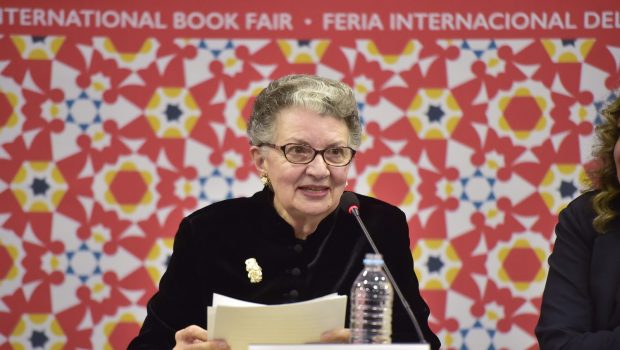Reconsidering the Mexican Revolution
Reconsideraciones sobre la Revolución Mexicana
John Hart
The delegates to the constitutional convention of 1916-1917 and the political leadership of the nation that emerged at the conclusion of the Mexican Revolution of 1910-1917 represented a broad cross-section of national political values. Their work, which emerged almost immediately after the strategic defeats of the Villistas and Zapatistas, became the basis for the progressive aspects of Mexican polity over the next half century.
The Constituyentes and initial government leaders included regional and local elites, military men, professionals and even former anarcho-syndicalist red battalion commanders. They laid out a framework in the Constitution which they anticipated would satisfy the aspirations of all those who had fought during the revolution. Their agrarian reform program and political outline for the nation provided for Municipios Libres, or free and independent pueblos economically based upon their ownership of local land resources. At that time the overwhelming majority of Mexicans were rural and these constitutional provisions and government programs would immediately pacify most Villistas and Zapatistas, their former
But the programs they initiated went much further than the achievement of short term social stability. Beginning with the Constitution, the victorious allies embarked on an enormous national-building program. This project included schooling, the arts and music. All three dimensions of the effort transmitted a profound pride in being Mexican to the general public, workers, campesinos and indigenous people. Educational theorists such as Moisés Saenz and José Vasconcelos designed the public education curriculum in a manner that complemented the work of American educator John Dewey that was intended to turn the marginalized and poverty- stricken masses into fully participating citizens. They obtained a commitment from the heads of government that finally totaled twenty-three percent of the national budget and remained at that level for the next seventy years.
The arts and music comprised an equally profound force for national unity and participation. The composer and conductor Carlos Chávez brought together pre-Columbian Mesoamerican instrumentation with European and to some degree, even African rhythms. Supported by the Secretariat of Public Education, his lengthy Indiana featured Aztec-era wind and percussion instruments within a Western European symphonic framework and received national and even international acclaim. While Chávez’s music did not appeal so much to the popular ear, it helped legitimize Mesoamerican culture in the consciousness of European critics who were otherwise oblivious to pre-Columbian achievements in astronomy, town planning, hydraulic agriculture and mathematics.
The plastic arts immediately took part with an explosion of creative energy released after centuries of Spanish and Porfirian elite-driven and dictatorial restraint. Beginning most notably with the work of Gerardo Murillo at the Academy of San Carlos in Mexico City, young students, including Diego Rivera, began to flourish. Murillo sent him to Paris to work with Pablo Picasso, and Rivera quickly appreciated the deeper theoretical nature of Picasso’s work. It amounted to an artistic Albert Einstein, breaking down structuralism to see the internal complexities, in what was soon after called post-modernism in the literary world created by Octavio Paz, Carlos Fuentes and Juan Rulfo.
Rivera, José Clemente Orozco, David Alfaro Siqueiros, and Frida Kahlo brought the masses and women into their work, depicting the struggle of popular culture against the forces of conquest, colonialism, clerical oppression, and elite proto-European hegemonies. The result was a graphic art that amazed the world and reached out to the most oppressed poverty-stricken people in Mexico telling them that, yes, you can regenerate and do so on your own terms. During the following decades enrollment at the National Autonomous University of Mexico (UNAM) was virtually free.
Revolutionary changes in the political economy of Mexico equaled those in the arts, literature and public consciousness. The leaders of the new government followed up on the actions of local citizenries and the Constituyentes, and by 1940, they had seized all of the foreign-held lands on the coasts and borders. Some 80 percent of these strategically important properties had been held by American oligarchic and British Imperial interests. The Lázaro Cárdenas regime enlarged on that program by seizing the communications and transportation industries and created 55—50 partnerships with the foreigners in high-tech mining and timber operations while ending segregated housing and discriminatory salaries that separated Mexican and foreign workers. Agrarian reform and Mexican self-management sent real wages up at the rate of five percent a year between 1936 and 1940, creating an unprecedented level of workers’ well-being.
Simultaneously, the new governments created a more participatory polity, welcoming anyone who was willing to join the official party via unions, local agrarian committees or businessmen’s groups. Using the credo of building revolutionary institutions, the leadership created a bureaucracy numbering in the hundreds of thousands that administered the laws limiting the un challenged power of the Mexican and foreign oligarchies that had dominated the nation under the ancient regime. In sum, the revolutionaries achieved, in a period of two generations, a system in which the general populace assumed a much greater role in virtually all matters.
The failures of the revolutionary elites, however, eventually undid these achievements and constitute a tragedy. After only constraining the nation’s domestic oligarchy, the political leadership began to intermarry with the old rich, creating a more conservative layer of leadership that began to emerge during the 1940s. After 1940, they failed to deal with the runaway population growth that began as a result of their social successes. That runaway growth quickly obliterated the gains in education, real wages, and economic expansion. A new oligarchy began to emerge exercising control over labor unions, production, agricultural exports and political authority.
CONTEMPORARY MEXICO
Today, enormous disparities of income, owned wealth, and education rank Mexico among the most inequitable societies in the world. It is now a nation in which a few enjoy unimaginable wealth in the midst of squalor and misery that defies description. The idea of a predominately rural Mexico where those who worked the land held an inalienable right to it has been marginalized in a nation which is 72 percent urban. Beginning in the 1940s, government programs focused on urban development and human services. That strategy provided a strong economic impetus to the emerging new oligarchy and the free-trade and privatization policy forcefully introduced by the “Juniors” during the administration of Miguel de la Madrid (1982-1988).
During that sexenio, the president privatized over three-fourths of the nation’s more than 1600 cooperatives. In 2008, only 150 cooperatives remained. Once again artisans, miners, and fishermen, became employees. The weakness of rural working-class support programs in the last half of the twentieth century compelled the majority of campesinos to immigrate to the burgeoning cities. The new oligarchy had established special relationships with much more powerful economic interests in the United States to provide a super exploitable labor force. The coastlines and frontiers have been compromised to foreign interests via 99-year leases. Since 1994, the North American Free Trade Agreement (NAFTA) largely has destroyed the agrarian reform program by the mass importation of U.S. government-subsidized corn. The petroleum industry is characterized by segregated labor by which American engineers are brought in to perform high-skill jobs and thus enjoy much higher wages. Real wages for the nation’s workers have fallen to 1970s levels.
In the sphere of cultural creativity, Mexico is still thriving. The nations’ long standing commitment to the spirituality of Mesoamerica seen in the work of Rulfo and Rivera and its relationship with modernity as seen in the work of the masters is now complemented by Cristina Rivera Garza and her psychological linkages of past and present. The plastic arts are also diversifying with a more pre-revolutionary art called the Mexican Renaissance emerging alongside the continuing mural and vivid color displays long identified with Rivera and Siqueiros. This mixture of old and new thinking in the arts and literature is perhaps the model that the nation’s political and economic elites should follow.
Los delegados de la convención constitucional de 1916-1917, y el liderazgo político que surgió al final de la Revolución Mexicana (1910-1917), compartían valores políticos nacionales con una gran parte de la población mexicana. Su trabajo, que inició casi inmediatamente después de las derrotas de los villistas y zapatistas, fue la base de los aspectos más progresivos de la estructura política que existiría 50 años después.
Los constituyentes y los primeros líderes en el gobierno incluían a miembros de la elite local y regional, militares, profesionistas e incluso antiguos comandantes y sindicalistas anárquicos del batallón rojo. Propusieron una estructura constitucional que dejaría satisfechas las aspiraciones de aquellos que habían luchado en la Revolución. Su programa de reforma agraria y esquema político permitieron la existencia de municipios libres, o pueblos libres e independientes que fundamentaban su economía en la posesión de tierras y recursos locales. En esa época, la gran mayoría de los mexicanos era de origen rural y estas disposiciones constitucionales y programas gubernamentales pacifi caron de inmediato a los villistas y zapatistas, sus antiguos rivales, y los convertiría en sus aliados.
Pero los programas que iniciaron fueron más lejos que el logro de una estabilidad social a corto plazo. Empezando por la Constitución, los aliados se embarcaron en la reconstrucción del país con programas de desarrollo educativo e impulso a las artes y la música. El esfuerzo en estas tres áreas transmitió al pueblo un profundo orgullo por ser mexicanos. Teóricos en educación como Moisés Sáenz y José Vasconcelos, diseñaron la educación pública en cierta manera influidos por el trabajo del estadounidense John Dewey, quien buscó convertir a las masas empobrecidas y marginadas en ciudadanos completamente involucrados con su sociedad. Obtuvieron un compromiso económico del gobierno que representaría el 23% del presupuesto nacional para los próximos setenta años.
Las artes y la música fueron una fuerza unificante en términos de participación y solidaridad nacional. El compositor y director Carlos Chávez fusionó instrumentación europea y mesoamericana de la época prehispánica, e incluso ritmos africanos. Apoyado por la Secretaría de Educación Pública, su obra Indiana presentó instrumentos de vientos y percusiones de épocas aztecas en un contexto europeo occidental, lo que le valió reconocimiento nacional e internacional. Aunque la música de Chávez no era del gusto del oído popular, ayudó a legitimizar la cultura mesoamericana en la conciencia de los críticos europeos, los cuales desconocían los logros prehispánicos en astronomía, planeación urbana, agricultura hidráulica y matemáticas.
Las artes plásticas participaron en el movimiento con una explosión de energía creativa que había sido reprimida por las fuerzas de las dictaduras españolas y porfirianas durante siglos. Comenzando con las notorias obras de Gerardo Murillo en la academia de San Carlos en la Ciudad de México, muchos jóvenes estudiantes comenzaron a descollar, entre ellos Diego Rivera. Murillo mandó a Rivera a París para que trabajara con Pablo Picasso, y Rivera comenzó inmediatamente a apreciar los aspectos más profundos y teóricos de la obra de Picasso. Lo que resultó fue un Albert Einstein artístico, quien logró desmenuzar el estructuralismo en la pintura para poner en evidencia sus complejidades internas y al que pronto se le llamó postmodernismo en el nuevo mundo literario creado por Octavio Paz, Carlos Fuentes y Juan Rulfo.
Rivera, José Clemente Orozco, Alfaro Siqueiros y Frida Kahlo incluyeron a las mujeres y a las masas en su trabajo y en el cual describieron la lucha entre la cultura popular y las fuerzas de la conquista, el colonialismo, la opresión del clérigo y la elite de hegemonías protoeuropeas. El resultado fueron obras que sorprendieron al mundo entero y llegaron hasta los pobres y más oprimidos de México, señalándoles que, efectivamente, era posible regenerarse por sí mismos. En las décadas que siguieron, la inscripción en la Universidad Autónoma de México fue prácticamente gratuita.
Los cambios revolucionarios en la economía política de México fueron iguales a los cambios en las artes, la literatura y la conciencia pública. Los líderes del nuevo gobierno dieron seguimiento a las acciones de la ciudadanía y los constituyentes, y para 1940 habían tomado toda la tierra que se encontraba sobre las costas y fronteras y que había estado en posesión de extranjeros. El 80% de estas propiedades con valor estratégico habían sido poseídas por los intereses estadounidenses oligárquicos e intereses imperialistas ingleses. El régimen de Lázaro Cárdenas se robusteció al expropiar las industrias de comunicaciones y transporte, creando sociedades de 55-45% con empresas de tecnología minera y de madera mientras le ponía fin a la marginalización residencial y a la indiscriminada desigualdad salarial entre extranjeros y mexicanos. La reforma agraria y la auto-administración mexicana incrementaron los salarios reales en un 5% anual entre 1936 y 1940, lo cual mejoró la calidad de vida de trabajadores a un nivel sin precedentes.
Al mismo tiempo, se creó una estructura política más participativa dándole la bienvenida al que quisiera inscribirse al partido ofi cial a través de sindicatos, comités agrarios locales o grupos de inversionistas. Con el credo de la construcción de instituciones revolucionarias, los líderes crearon una burocracia con cientos de miles de miembros que administraron las leyes que limitaban a las oligarquías que habían dominado la nación bajo el antiguo régimen. En resumen, lo que los revolucionarios lograron en el transcurso de dos generaciones fue un sistema en el cual el pueblo asumió una mayor participación en todos los aspectos.
Sin embargo, los fracasos de la elite revolucionaria deshicieron estos avances, lo que constituye una tragedia. Después de restringir y no eliminar la oligarquía doméstica, el gobierno comenzó a asociarse con los miembros de la alta sociedad, creando el liderazgo aún más conservador que comenzó a surgir en los años cuarenta. Después de 1940 fracasaron al enfrentarse con la explosión demográfi ca que se dio gracias a sus logros. Este crecimiento obliteró los avances en educación, salarios y crecimiento económico. Surgió una nueva oligarquía que tomó control de sindicatos laborales, producción, exportaciones agrícolas y autoridad política.
MEXICO CONTEMPORÁNEO
En la actualidad, la enorme disparidad que existe en los ingresos, riqueza y educación han puesto a México entre los países más desiguales del mundo. Ahora es una nación en la que sólo un grupo reducido de personas tiene acceso a una riqueza inimaginable en medio de una miseria indescriptible. La idea de México como un país rural donde el que trabajaba la tierra era dueño de ella ha quedado al margen en un país que cuenta con el 72% de urbanización. Empezando en los cuarentas, los programas de desarrollo gubernamental se concentraron en el desarrollo urbano y los recursos humanos. Esta estrategia provocó un ímpetu económico a la oligarquía que se estaba formando y la política de privatización del libre comercio que fue introducida a la fuerza por los juniors durante la presidencia de Miguel de la Madrid (1982-1988).
Durante este sexenio, el presidente privatizó más de tres cuartas partes de las 1600 cooperativas de la nación. En el 2008, solo quedaban 150 de ellas. Una vez más, los artesanos, mineros y pescadores se volvieron empleados. La debilidad de los programas para el apoyo de obreros rurales en la segunda parte del siglo XX han forzado a muchos campesinos a emigrar a las ciudades que comenzaban a prosperar. La nueva oligarquía ha establecido relaciones especiales con intereses mucho más poderosos en los Estados Unidos para proveer una mano de obra mucho más barata y fácil de explotar. Las costas y fronteras han sido rentadas a entidades extranjeras en arrendamientos de 99 años. Desde 1994, el Tratado de Libre Comercio ha destruido en gran parte al programa de reforma agraria al importar las producciones subsidiadas por el gobierno estadounidense de maíz. La industria petrolera está caracterizada por una discriminación laboral en la cual ingenieros extranjeros son importados para hacer trabajos de alta dificultad, lo cual les da el beneficio de un mayor salario. Los ingresos de la población han caído a los niveles de los años setentas.
En el ámbito de creatividad cultural, México sigue floreciendo. El compromiso de la nación con la espiritualidad de Mesoamérica que se observó en las obras de Rulfo y Rivera y su relación con la modernidad en el trabajo de los maestros es ahora complementado por Cristina Rivera Garza y sus lazos psicológicos que ha trazado entre el pasado y el presente. Las artes plásticas se han diversificado con un arte prerrevolucionario llamado el Renacimiento Mexicano, que ha surgido mientras se siguen apreciando los colores y murales que siempre se han atribuido a Rivera y Siqueiros. Quizá esta mezcla de viejas y nuevas ideas en las artes sea el modelo que debería de seguir la elite política y económica.










